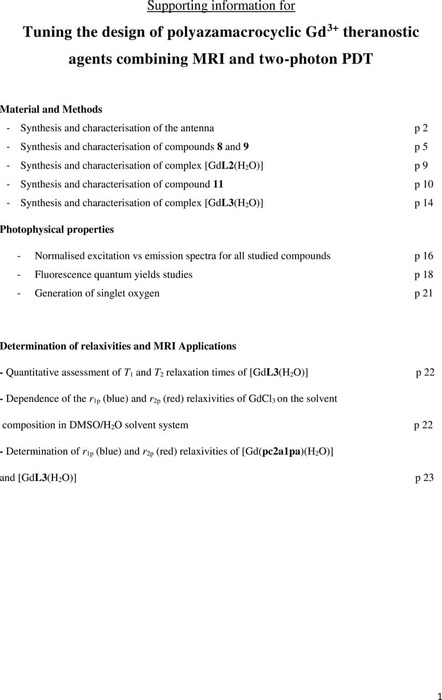Abstract
New “all-in-one” theranostic systems, combining a magnetic resonance imaging (MRI) contrast agent with a
biphotonic photodynamic therapy (2P-PDT) photosensitiser generating cytotoxic singlet oxygen, were envisaged and
synthesised. They are based on azamacrocycles, regiospecifically functionalised by two-photon PDT π-conjugated
dibromobenzene-picolinate photosensitisers and acetate, able to complex gadolinium(III) and allow an MRI signal. Our
approach was to use two different macrocyclic platforms, tacn and pyclen, for modulating simultaneously the structures,
properties and solubility of the complexes. Photophysical properties of the ligands and their gadolinium(III) complexes were
fully investigated. The Gd3+-pyclen derivative showed the best water solubility and the greatest value of singlet oxygen
generation of the series with φΔ = 0.53 enabling in vitro studies. The biological PDT activity under mono and biphotonic
excitation was evaluated in human breast cancer cells (MCF-7). While a very low dark toxicity was observed, an almost total
cell death was induced after only 3 successive irradiations of 1.57 sec. Finally, its relaxivity was measured in a DMSO/H2O
solvents mixture with r1p = 11.21 and r2p = 24.60 mM-1s
-1 at 3.0 T and T1- and T2-weighted phantom MR images were obtained
highlighting a first generation of “all-in-one” PDT/MRI theranostic agents.
Content

Supplementary materials

ESI AbadHamon ChemRxiv 2020


![Author ORCID: We display the ORCID iD icon alongside authors names on our website to acknowledge that the ORCiD has been authenticated when entered by the user. To view the users ORCiD record click the icon. [opens in a new tab]](https://chemrxiv.org/engage/assets/public/chemrxiv/images/logos/orcid.png)



